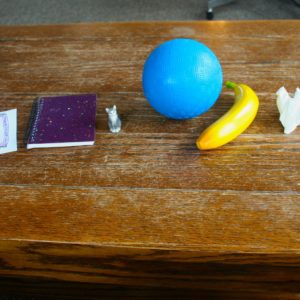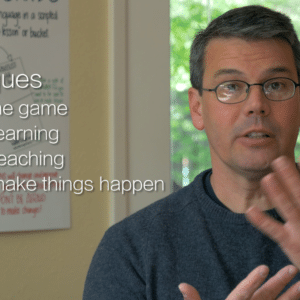Every skill has its secret techniques.
“Technique!” is the fundamental structural element of the WAYK system. With it players can name and share the techniques that will accelerate learning and teaching, incorporated as “rules of the game”.
The line between students and teachers is the biggest obstacle in education.
The teacher is the boss. The students are the obedient workers. How well does this well-worn, institutional model serve our learning? Many of us experienced at least one or two truly excellent teachers in our years of schooling – heroic role-models who brought the best out of us as students. These teachers are honored as an inspiration – but are uncommon and in high demand. Put one student with such a teacher, and they’ll experience more success, and receive credit for it. Remove that student from that teacher, and watch their success diminish, and this too they will be given credit for (and graded more harshly because of it). Yet it was the teacher that made the difference, not the student.
What if the best teachers performed so well because of special techniques they wielded, consciously or not? Rather than personal virtues, what if these techniques were learnable skills? Do the most skillful learners already practice some of these techniques?
As a matter of fact, there are many well-known techniques for accelerating learning, such as peer mentoring, total physical response, the use of games and play.
If you as a teacher know one thing that will accelerate your students’ learning, why not share it with them, rather than hiding it behind pre-designed curriculum? Why not turn the tables and make them responsible for accelerating your teaching?
If you as a student know one thing that will accelerate your learning, why not share it with the teacher, rather than deferring to their higher authority? Why not turn the tables and make the teacher responsible for accelerating your learning?
Once everyone is aware of a common pool of “things that will make learning and teaching faster”, what if we give them names, to speed up using them? Then together we have a mentoring language, a way of quickly speaking about and collaborating on what works.
“How Fascinating! Your set-up might need to be more obviously! – what if you tried limiting the visual noise by using a table cloth? By doing this, in my last game, the group went all the way to the want/have/give/take conversation in just 30 minutes.“
Once you accept the egalitarian nature of learning, where the roles of student and teacher begin to erode, you discover a continuum of relationships along which learning gets faster and faster.
First, there is teacher/student (the slowest learning, common in institutions).
Then, there is master/apprentice (faster, because it focuses on mentoring and competency, but it still compartmentalizes responsibility).
Then, there are Fluent Fool*/Fluency Hunter* (even faster – the “student” has completely taken charge because the other knows nothing about teaching).
Then finally, there is Fluency Hunter with the skill/Fluency Hunter without the skill (blazingly fast – one hunts the skill from another, using accelerators in tandem).
* These are WAYK techniques that will be explained later; essentially, a Fluency Hunter is an assertive, skillful player of WAYK, and a Fluent Fool is competent in the target skill but has no experience teaching.
Introducing the technique
Short: “This is a game, and every time I make this sign, I’m marking a ‘rule of the game’.”
Longer: “This sign is ASL for ‘technical’ or ‘technique’; every ‘rule’ of the game is a technique for accelerated learning and teaching.
Applying the technique in language acquisition
The American “time-out” sign was originally used in WAYK play, before players innovated “technique!” . This reflects its primary purpose: to provide an opportunity to reflect on what just happened, check for questions, and improve the play of the game.
- Use the “technique!” hand sign any time there is a pause or confusion in the game.
- When a player has a concern or request, see if you can call up an already established technique; if one doesn’t exist, innovate a new one on the spot with the help of the player. Give them credit for inventing a new “rule of the game”!
- Any time you find yourself “explaining” the game, you probably need a technique. Either an already existing one, or one that needs to be invented.
- Techniques are best presented as “rules of the game”, rather than claims about reality; players won’t understand them anyway until after they’ve experienced the fun and success of rapid language acquisition for themselves.
- Be willing to change technique names, and innovate new techniques, just for the group you’re working with at that time. Techniques are designed to be personalized.
- There is a constant tension between techniques that seem almost universal, and techniques that only work for certain groups or situations. This is just part of play.
- You know marking a technique is useful if it makes the game go faster; if marking a technique doesn’t make the game go faster, then don’t bother mentioning it.
- Techniques are agreements between players on how to play the game of language acquistion, driven by tq “Obviously!”.
But what about…?
“I’m here to learn my target skill. I don’t want learn new techniques, do any teaching, or play a game.” We run into players like this from time to time – usually older, they’ve spent a lifetime in a certain role that they feel very comfortable with. Perhaps they’ve experienced success in that role, and don’t want to risk trying a new one.
You as a fluency hunter choose who to play with. The more accelerators you wield beyond your current ability, the more you may overwhelm (TQ “Sorry, Charlie!) yourself. Many ‘rules of the game’ are specifically aimed at deciding who to play with, and what roles they’ll fill.
• TQ Warm, Rested, Fed, Safe, Willing ensures players who are ready to play.
• TQ Teach a Teacher is one of the primary accelerators – there is no game without it.
• TQ We’ll All Get There Together means that though a player might not be ready now, they may find a role in the game later, if given time and enough space to settle in. If they have the skill you want to hunt, then they are your TQ Fluent Fool. It’s not necessary to play the game in order to participate in the game.






Wow! I wonder if someone of you WAYK people is planning to go to Europe, especially Switzerland? Do you do sign language?
We have no current plans to come to Europe, although we’ve been looking into bringing WAYK there. I’ll email you and we can start a conversation.
yrs,
Willem
Hi Willem,
Has WAYK come to Europe yet? Whether or not, I DO want to start the game here in Hungary. I am reading the WAYK blog posts and wiki, watching the videos, and getting more and more amazed. Thank you all for all this.
Cheers from Budapest,
Botond
It could be wonderfull if you can come to South America, especially to Ecuador (I’m from Quito), I want to apply this system in a language club to teach Esperanto, Español and maybe Latin.
Esperanto is completely regular and easy, so WAYK can be excellent to apply.